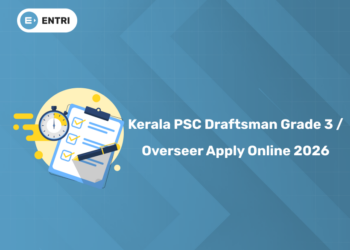Table of Contents
Kerala PSC HSST Commerce Mock Test 2024: Are you preparing for the Kerala PSC HSST Commerce Exam 2024? Whether you’re a first-time test taker or looking to improve your score, practicing with mock tests is crucial for success. Practicing mock tests allows you to assess your knowledge across these areas and adjust your preparation accordingly. Here we aim to provide valuable insights and strategies to excel in the upcoming KPSC HSST Commerce Examination 2024. Attempt the Free mock test series now!
Kerala PSC HSST Commerce Notification 2024: Highlights
| Event | Details |
| Name of Exam | Higher Secondary School Teacher Junior (Commerce) |
| Category Number | 127/2024 |
| Conducted for | Educational Department |
| Exam Organizing Body | Kerala Public Service Commission (KPSC) |
| Level of Exam | State Level |
| Vacancy | Anticipated |
| Application Status | Open |
| Notification Release Date | June 15, 2024 |
| Application Starts | June 15, 2024 |
| Last Date to Apply | July 17, 2024 |
| Recruitment type | Direct |
| Mode of Exam | Online |
| Exam Duration | 1 Hours 30 Minutes |
| Official Website | keralapsc.gov.in |
Kerala PSC HSST Commerce Previous Year Question Paper PDF
1: The first recipient of the ‘Rajiv Gandhi Khel Ratna’ award?
| Year of Exam | |
| 124/2014 | |
| 221/2015 | |
| 003/2016 |
Enroll in Kerala's Top-rated HSA Coaching Program!
സർക്കാർ ജോലി എന്ന സ്വപ്നം ഇനി സ്വപ്നം മാത്രമല്ല! Join Entri's HSA Coaching Program
Join Now!Kerala PSC HSST Commerce Mock Test 2024: Attempt Link
Free Series: Kerala PSC Higher Secondary School Teacher Mock Test 2024 – Dive into the Challenge!
| Mock Test Series | Link |
| Module – 1 | |
| Module – 2 | |
| Module – 3 | |
| Module – 4 | |
| Module – 5 | |
| Module – 6 | |
| Module – 7 | |
| Module – 8 | |
| Module – 9 |
Kerala PSC HSST Commerce Mock Test 2024 Sample
Section A: Financial Accounting (Module I)
1. What does GAAP stand for in accounting?
- A) Generally Analyzed Accounting Principles
- B) Generally Accepted Auditing Procedures
- C) Generally Accepted Accounting Procedures
- D) Generally Accepted Accounting Principles
2. Which financial statement reports a company’s financial position at a specific point in time?
- A) Income Statement
- B) Balance Sheet
- C) Cash Flow Statement
- D) Statement of Retained Earnings
3. The double-entry accounting system is based on:
- A) Single entry of transactions
- B) Recording each transaction with a debit and a credit
- C) Documenting transactions without categorization
- D) Using only cash transactions
4. Ratio analysis helps in assessing a company’s:
- A) Social responsibility initiatives
- B) Financial performance
- C) Employee turnover rate
- D) Marketing strategies
5. Which of the following is a liquidity ratio?
- A) Return on Investment (ROI)
- B) Debt-to-Equity Ratio
- C) Current Ratio
- D) Price-to-Earnings (P/E) Ratio
Section B: Advanced Cost Accounting (Module II)
1. Marginal costing primarily focuses on:
- A) Total cost of production
- B) Fixed costs only
- C) Variable costs and their behavior
- D) Historical cost analysis
2. The breakeven point is where:
- A) Total revenue equals total variable costs
- B) Total revenue exceeds fixed costs
- C) Total revenue equals total costs
- D) Total variable costs are zero
3. Standard costing involves:
- A) Estimating costs based on historical data
- B) Setting predetermined costs for production
- C) Calculating costs based on market trends
- D) Adjusting costs based on seasonal changes
4. Master budget includes:
- A) Detailed plans for a short-term period
- B) Comprehensive financial plans for the entire organization
- C) Budget plans for individual departments
- D) Budgetary control measures only
5. Flexible budgeting is useful because it:
- A) Limits expenditure to a fixed amount
- B) Adjusts for changes in activity levels
- C) Focuses on fixed costs only
- D) Ignores variable costs
Section C: Management Principles and Techniques (Module III)
1. Which of the following is not a function of management?
- A) Production
- B) Planning
- C) Organizing
- D) Controlling
2. Motivation theories primarily aim to:
- A) Maximize profits
- B) Understand what drives employees
- C) Improve customer satisfaction
- D) Enhance product quality
3. Effective leadership is characterized by:
- A) Micromanagement
- B) Inspiring and influencing others
- C) Strict control over employees
- D) Avoiding risks
4. Total Quality Management (TQM) emphasizes:
- A) Maximizing sales revenue
- B) Continuous improvement and customer satisfaction
- C) Reducing production costs
- D) Expanding market share
5. The process of recruiting, selecting, and training employees falls under:
- A) Production management
- B) Financial management
- C) Marketing management
- D) Human Resources Management (HRM)
Section D: Taxation Laws (Module IV)
1. Income Tax in India is levied based on:
- A) Annual turnover
- B) Capital gains only
- C) Total income earned during a financial year
- D) Export revenue
2. Goods and Services Tax (GST) is applicable on:
- A) Exports only
- B) Domestic sales only
- C) Both goods and services
- D) Agricultural products only
3. Tax planning primarily involves:
- A) Avoiding tax payments altogether
- B) Minimizing tax liabilities through legal means
- C) Delaying tax payments indefinitely
- D) Over-reporting income to reduce tax burden
4. Indirect taxes are collected from:
- A) Consumers through intermediaries
- B) Employees’ salaries
- C) Corporate profits
- D) Shareholders
5. Which of the following is an example of a direct tax?
- A) Excise Duty
- B) Income Tax
- C) GST
- D) Customs Duty
Section E: Research Methodology and Quantitative Techniques (Module V)
1. Research design involves:
- A) Conducting surveys only
- B) Planning the overall approach to a research study
- C) Analyzing data after collection
- D) Implementing statistical tests
2. Statistical tools like t-test are used to:
- A) Predict future trends
- B) Compare means between two groups
- C) Determine correlation coefficients
- D) Forecast sales figures
3. ANOVA (Analysis of Variance) is used to:
- A) Compare proportions in different groups
- B) Analyze differences among group means
- C) Test relationships between variables
- D) Determine statistical significance
4. Regression analysis helps in:
- A) Testing causality between variables
- B) Predicting outcomes based on relationships among variables
- C) Describing data distributions
- D) Conducting hypothesis tests
5. Which of the following is NOT a qualitative research method?
- A) Case study
- B) Regression analysis
- C) Ethnography
- D) Grounded theory
Section F: Management Information System and Security Analysis (Module VI)
1. What is the primary function of a Management Information System (MIS)?
- A) Reducing operational costs
- B) Maximizing shareholder wealth
- C) Facilitating decision-making processes
- D) Enhancing employee morale
2. Data encryption is an example of which data security measure?
- A) Authentication
- B) Confidentiality
- C) Availability
- D) Integrity
3. A case study involving MIS would typically focus on:
- A) Employee motivation strategies
- B) Improving organizational efficiency
- C) Sales and marketing techniques
- D) Financial auditing procedures
Section G: Recent Trends in Commerce (Module VII)
1. Blockchain technology is primarily associated with:
- A) Digital currencies and cryptocurrencies
- B) Online marketing strategies
- C) Social media analytics
- D) Cybersecurity protocols
2. E-commerce differs from traditional commerce mainly due to:
- A) Face-to-face transactions
- B) Online transactions and digital payments
- C) Localized marketing strategies
- D) Cash-based transactions
Section H: Teaching Aptitude (Module VIII)
1. Effective teaching requires:
- A) Understanding learner characteristics and adapting teaching methods
- B) Rigid adherence to syllabus guidelines
- C) Using only traditional teaching methods
- D) Ignoring individual student needs
2. Which teaching aid enhances visual learning in classrooms?
- A) Lecture notes
- B) Textbooks
- C) Audio-visual aids
- D) Whiteboards
3. What is a primary characteristic of qualitative research?
- A) Large sample size
- B) Statistical analysis
- C) In-depth understanding of phenomena
- D) Objective measurement
4. Ethical considerations in research primarily involve:
- A) Protecting participants’ confidentiality and privacy
- B) Maximizing research funding
- C) Ignoring potential risks to participants
- D) Expediting the research process
Section I: Indian Constitution (Module IX(a))
1. The Preamble to the Indian Constitution reflects:
- A) Specific rights of citizens
- B) Basic ideals and objectives of the Constitution
- C) Detailed legislative procedures
- D) Fundamental duties of citizens
2. Directive Principles of State Policy are primarily aimed at:
- A) Ensuring political rights of citizens
- B) Promoting social and economic justice
- C) Regulating state finances
- D) Protecting minority rights
3. The Right to Information Act (RTI) aims to:
- A) Restrict access to government information
- B) Ensure transparency and accountability in government
- C) Limit citizens’ access to public records
- D) Control media interactions with government officials
4. The Employment Guarantee Programme focuses on:
- A) Private sector employment opportunities
- B) Providing guaranteed employment to rural households
- C) Promoting entrepreneurship among youth
- D) Subsidizing agricultural production
Why I Attempt HSST Commerce Mock Tests 2024?
Mock tests simulate the actual exam environment, helping you familiarize yourself with the format, difficulty level, and time constraints of the Kerala PSC HSST Commerce exam. Here are a few reasons why mock tests are essential:
- Exam Simulation: Experience a simulated exam environment to reduce anxiety and increase familiarity with the exam structure.
- Identify Weaknesses: Discover your strengths and weaknesses in different topics and sections of the syllabus.
- Time Management: Practice managing time effectively, which is critical for completing the exam within the allocated time frame.
- Strategy Development: Develop effective strategies for tackling different types of questions and maximizing your score.











